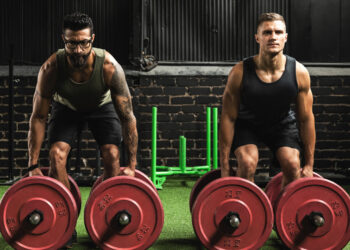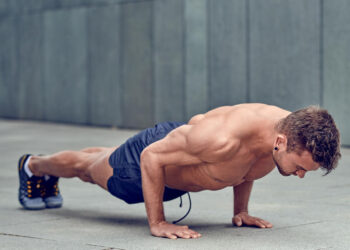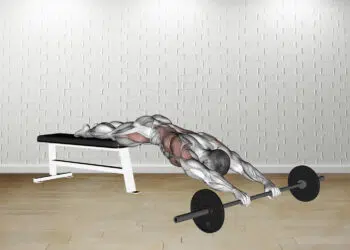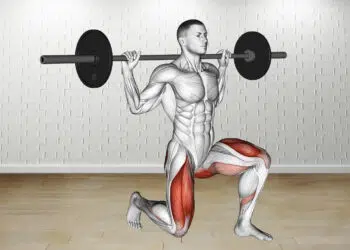V-ups are one of those rare exercises that combine a unique combination of core strengthening, explosiveness, balance, coordination, flexibility, stretch, and cardio fitness. Yeah, it’s one heck of a movement…
Consequently, v-ups require a more advanced ability. But if you can’t do them yet, we’ve included some progressions to build up your core strength, along with a few more advanced techniques if you’re ready for a more challenging v-up variation.
In this guide, you’ll learn proper v-up form, key benefits, variations, and optimal sets and reps.
Muscles Worked During V-Ups
An ab-focused exercise, let’s break down the function and anatomy of your core and assisting muscles.
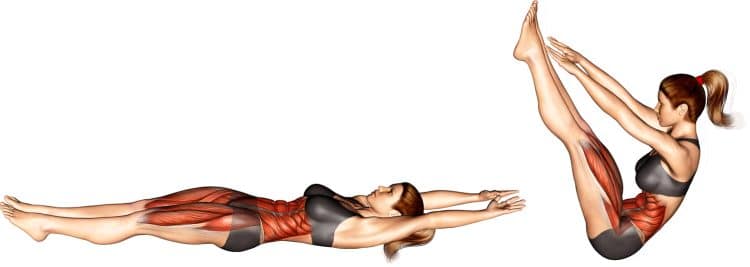
Rectus abdominis
Fitness enthusiasts rank the rectus abdominis, or six-pack abdominal muscles high on the priority list. A well-developed pair of abs ties everything together and everyone likes to show them off.
Located front and center on the anterior midsection, abs are responsible for spine flexion, which crunches the upper and lower trunk in the same direction.
Level Up Your Fitness: Join our 💪 strong community in Fitness Volt Newsletter. Get daily inspiration, expert-backed workouts, nutrition tips, the latest in strength sports, and the support you need to reach your goals. Subscribe for free!
V-ups are a popular rectus abdominis exercise because they challenge the muscles, and should promote a better core.
Transverse abdominis
Rectus abdominis are the more superficial abs, while transverse abdominis are the deeper core muscles. Like a weightlifting belt, the transverse abs pull the belly button into the spine and compresses the abdomen to create a strong rigid midsection.
Strong inner abs are important for force transfer during big lifts and stability during v-ups.
Obliques
If you look at a lean physique with good ab development, you can see the oblique muscles on either side of the rectus abdominis.
While the obliques primarily contribute to rotational and lateral movements unlike rectus abdominis, they still come along for the ride in the driver’s seat during V-ups.
Hip flexors
Hips are a large group of muscles that attach the legs to the pelvis and vertebrae (spine), hence they participate in v-ups and benefit from the the movement.
There are five muscles that flex the hips.
- Iliacus
- Psoas (major and minor)
- Rectus femoris
- Iliocapsularis
- Sartorius
From this group, the iliacus and psoas (together form the iliopsoas) are the primary hip flexors and also the largest. While the other three muscles bend the hips to 90 degrees, iliopsoas muscles lift the knee higher than 90 degrees (e.g., when you pull the knees into the chest).
Here are brief descriptions of iliacus and psoas muscles.
Psoas – The psoas (pronounced so-as) connects from the lower back through the pelvis and attaches to the upper part of the femur (thigh bone). Its role is lateral rotation of the thigh and lateral flexion of the trunk while also functioning as a postural muscle, stabilizing the vertebral column during standing.
Iliacus – Iliacus is a hip rotator muscle that flexes the thigh and supports upright posture.
Benefits of V-Ups
V-ups are more than a basic ab crunch with additional elements, and consequently, benefits too. Let’s look at the advantages of including V-ups in your training.
Advanced bodyweight ab exercise
You can only do so much with basic bodyweight crunches before you’re wasting your time. Gains are made when the body is challenged and V-ups do it better.
That’s because when you involve the weight of the legs, you’re creating more resistance for the abs to work against. When both sides are crunching at the same time, you’re abs are working overtime!
Strong abs make everything else… better
A strong and healthy core is as important for performance as any other muscle. The rectus abdominis and deeper core muscles give us the flexibility, and rigidity to move around, lift more weight, and maximize our physical potential.
All-around functional
How are v-ups functional? They combine balance, coordination, stability, strength, and explosiveness all in one. If you’re an athlete of any kind, v-ups are the perfect bodyweight core exercise.
Build a more explosive midsection
You can make v-ups an explosive movement by performing them with more speed.
If you participate in athletic activities, v-ups are an easy way to build and maintain explosive power in your core muscles. The beauty is you don’t need weights or equipment to train functionally.
Level Up Your Fitness: Join our 💪 strong community in Fitness Volt Newsletter. Get daily inspiration, expert-backed workouts, nutrition tips, the latest in strength sports, and the support you need to reach your goals. Subscribe for free!
Get your cardio in too…
Unlike a basic abdominal crunch, v-ups are a total body exercise. The more muscles and movement, calories burned, and consequently, body fat too.
With a good diet, V-ups can be a great additional exercise in your cardio training lineup.
You don’t need anything to do V-ups
The incredible thing about V-ups and other effective ab variations is you don’t need the gym, bands, weights, or any equipment at all. Your body weight is the resistance and if you do V-ups correctly, they’ll help to improve your core.
V-ups are an excellent choice for home or travel ab workouts.
How To Do V-Ups
Keep in mind, there are different variations of v-ups ranging from beginner to more advanced, slower to more explosive. How you decide to execute the exercise will depend on your goals.
In this guide, we’ll show you how to do a few different versions of this beneficial movement.
Basic v-up steps
- Lie on the floor face up with your legs straight out, feet pressed together, and arms extended above your head.
- Brace your core by pushing the pelvis down, taking a breath in, and tensing the midsection.
- Then, simultaneously lift your legs up toward the center of the body, and reach your arms toward your toes.
- Reverse the motion and return to the starting position while keeping your heels a few inches off the floor. Your back should always be flat against the floor and your core tensed.
Here’s a video example.
Explosive v-up steps
One benefit of explosive v-up performed through a max range of motion is that it’ll really stretch those glute muscles.
- Lie on the floor face up with your legs straight out, feet pressed together, and arms extended above your head.
- Brace your core by pushing the pelvis down, taking a breath in, and tensing the midsection.
- Now explosively lift your legs toward your head while simultaneously reaching the arms up and past your outer ankles.
You can watch the 5-minute video below for a demonstration of some progressions and the explosive v-step.
Tips
- Try to keep your legs as straight as possible. Although, do not worry if you can’t. Try your best.
- You can perform the movement using a shorter range of movement as a progression to full v-ups.
- Your lower back should be flat against the ground for the entire exercise. If your lower back arches, the hip flexors will take over too much.
This Exercise
- Target Muscle Group: Rectus abdominis
- Secondary Muscles: Obliques, hip flexors
- Type: Strength, hypertrophy
- Mechanics: Isolation
- Equipment: N/A
- Difficulty: Intermediate
- Best Rep Range:
- Hypertrophy: 8-15
- Endurance: 15+ reps
Common Mistakes While Performing V-Ups
Here are a few bad habits to avoid when performing V-ups.
Flailing legs
You won’t have the balance, stability, and optimal focus if your legs are flopping around during v-ups. It really helps to gently press your toes together which will help you to maintain proper energy balance throughout your body.
Forcing the movement when you lack the ability
If you cannot do v-ups properly because you lack balance, core strength or stability, coordination, etc, then you’re better off starting with easier progression like cocoons, or simply leg lifts.
Then, as you build more strength, you can continue progressions until you can do v-ups.
5 Variations and Alternatives of V-Ups
These variations can be used as regressions and progressions to v-ups.
Wide leg progression
More of a progression, if you cannot do v-ups, spread or straddle your legs, and reach through with your arms lower to your body, rather than reaching up toward your toes like you’d do when performing v-ups.
Steps
- Lie flat on your back with both arms reached overhead so your biceps are near your ears. Move your feet apart from each other in a wide stance.
- Breathe out, pull your pelvis down to the floor, and tighten your core muscles.
- Now simultaneously bring your legs up toward your head and push your arms through the center, parallel to the floor.
- Reverse the movement, and keep your heels a few inches above the floor. Repeat.
Pro tip: If you struggle to keep your legs straight, try the bent knee modification.
Hollow holds
V-ups and other challenging ab variations require lumbar stability, strength, and core endurance. Hollow holds are a core exercise that prepares you for those types of movements and other activities via isometric strengthening.
Steps
- Lie on your back with the legs straight out, feet pressed together, and arms extended overhead.
- Prepare your core muscles by pulling your pelvis down in line with the ribcage, taking a breath in, and tensing your midsection. Your lower back should be in contact with the floor.
- Lift your feet, legs, shoulders, and arms off of the floor as shown in the video example below. Only the lower third of your back should be in contact with the ground. Point your eyes at your toes but don’t tuck the chin.
- Hold for just a few seconds and then relax. Repeat.
Straight leg crunches
If you cannot do v-ups yet, you may be able to start with vertical leg crunches. To do this variation, you’ll raise both legs perpendicular to your body while reaching up to the toes.
Steps
- Choose a flat, level surface to perform the exercise.
- Lie on the floor with your arms reached overhead, legs extended, and feet together.
- Engage your core muscles and simultaneously lift your legs as vertical as you can while reaching up toward your toes. Exhale during this portion of the movement.
- Slowly lower your legs and arms back to their original position while keeping the core tense and inhaling. Repeat the movement for the desired number of repetitions.
Cocoons
Cocoons are a less challenging variation of V-ups. As the name implies, the movement involves bringing the arm and legs together in a way that resembles the protective casing that surrounds an insect during its developmental stage.
Steps
- Lie on your back with your legs extended and arms extended behind your head.
- Pull your knees in toward your chest and lift your butt up while simultaneously bringing your arms all the way toward and over your knees to perform a crunch.
- Return to the starting position but this time, keep your legs off the ground high enough to where your lower back is still mostly in contact with the ground.
- Repeat for the desired number of reps.
Weighted v-ups
You can up the ante by holding a weight in hand or strapping on some ankle weights for extra resistance. However, this variation is only recommended for advanced exercisers who’ve mastered bodyweight-only v-ups.
Pro tip: We recommend holding a medicine ball because it’s safer than a heavy dumbbell. You can also hold a swiss ball in your hands or between your feet for a little added resistance.
Frequently Asked Questions
What are the best sets and reps for v-ups?
It depends on your experience level and goals. However, it’s also harder to determine the optimal rep range with bodyweight exercises because you cannot control the resistance.
However, an optimal range for most people is 2-3 sets x 6-12 reps for strength and hypertrophy, and 15+ reps for core muscle conditioning and strength.
What are some simple ways to make v-ups more challenging?
A few methods include performing reps slower, holding weights/using ankle weights, increasing the range of motion, or using more advanced variations.
Wrapping Up
The verdict is in! V-ups are a good intermediate-level core exercise for those who want to progress some of the more basic ab movements. Involving so many different aspects of physical performance, it’s hard to find such a convenient, equipment-free exercise with so many transferable benefits.
While a great stand-alone exercise, v-ups are best paired with other variations as part of a well-rounded core training regime. If you can’t do a standard v-up, consider using the progressions in this guide, and once you’ve nailed a perfect v-up, there are more advanced options too!
Interested in measuring your progress? Check out our strength standards for Crunches.




